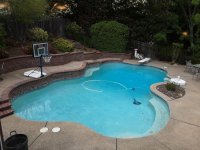^^^What are these measurements? Can you post a picture of the entire pool?
As I said, it's an odd-shaped pool, so I made several calculations which range from overestimates to underestimates, just to be sure I covered all bases. At the time I was thinking that once I had all my possible capacities it would be better OVERestimate since having too much FC would be better than having too little in my quest to battle algae which had been plaguing me. And, like most folks, is why I initially came to this forum.
That said, here's how I arrived at my figures. As you can see by the pic, this is not a standard pool. It is not even kidney-shaped. It's more like a rectangular organ with tumors, which makes it hard to measure. Depending on where I take measurements, length ranges between approximately 33' and 35', and width ranges between approximately 15' and 20'. Shallow end is 4', deep end end is at least 8' (couldn't measure exact middle of deep end). I do realize that curves can negatively affect capacity, hence why I took conservative calculations into consideration (as best as I could), as well.

Calculations:
1) 33 x 19 x 6 x 7.5 = 28,215 used widest point
2) 33 x 15 x 6 x 7.5 = 22,275 used narrowest point
3) 32 x 19 x 5.75 x 7.5 = 26,200 more conservative on length and depth to try and accommodate for weird shape
4) Combo 1
Shallow: 20 x 15 x 4 x 7.5 = 9,000
Deep: 17 x 16 x 8 x 7.5 = 16,320
9,000 + 16,329 = 25,320
5) Combo 2
Shallow: 21 x 14.5 x 4 x 7.5 = 9,135
Deep: 17 x 18 x 8 x 7.5 = 18, 360
9,135 + 18,360 = 27,495
I chose #5 to base my initial chemical dosing requirements on, to be safe, and initially added lower than recommended amounts, followed by testing, and adding more if necessary, to see what I really needed. I logged everything. That's how I know, for example, that Poolmath is dead on with my Muriatic acid needs.
Interestingly, until this year, I never even questioned Poolmath chlorine dosage recommendations, and just added what it recommended. Only this year have I really paid attention, and noticed that I need much less chlorine.
I've never added calcium or CYA (intentionally) before. But we had 12 atmospheric river weather systems hit us in 3 months this winter. Each of them is supposed to contain more water than the Mississippi River! And, I believe it, based on the rain we got. When those weather events hit, many of my neighbors were draining their pools with hoses, so I knew my pool had to be draining a lot of water through my overflow port. I kept my pool pump going as usual, as well as my cleaner, so I know my water was well mixed while it was raining and draining. It makes sense to me that my CYA and CH content plummeted. When I went to add them back in, I was told to add significantly less than the dosage recommended, and monitor changes before adding the rest. I noticed that I needed to add less than the recommended dosage amounts. I didn't think anything of it, and just thought it was a nice little money savings. Now, while I was monitoring those additions so carefully, I was also being diligent in keeping FC and PH in check, too. That's when I noticed the chlorine dosage discrepancy. I decided to play it safe and double-check my testing with Leslie's testing. Both report the same, so I know my tests aren't off. Algae has receded (pool pump died right before i added CYA and calcium - took 10 days for new pump to arrive and replace) and I only have a little of the black algae left, which is why I was being sure to keep FC on the high side to begin with. And my water is crystal clear.
I'm not complaining, by any means. I'm thrilled to have found TFP, and am happy that my water has never been better. I'm happy to use less chlorine. Less chemicals is better for me and my wallet! It's just odd that the dosage discrepancy is, in my case, so significant. Even if I use the lowest capacity based on calculation #2, chlorine recommended dosage is still way off. Like Marty alluded to, I would have to be off by way more than 50%. And, if I'm off, ok, someone please help me figure out what capacity I really have. If it's less, then great, theoretically more savings for me. But, I've been balancing my pool since I've been on here using a combination of Poolmath suggestions and adjusting and testing, so even if i find I have less capacity, it's likely not going to change what I'm using/spending now. But it would be nice to KNOW what I have. Knowledge is always a good thing to have.







